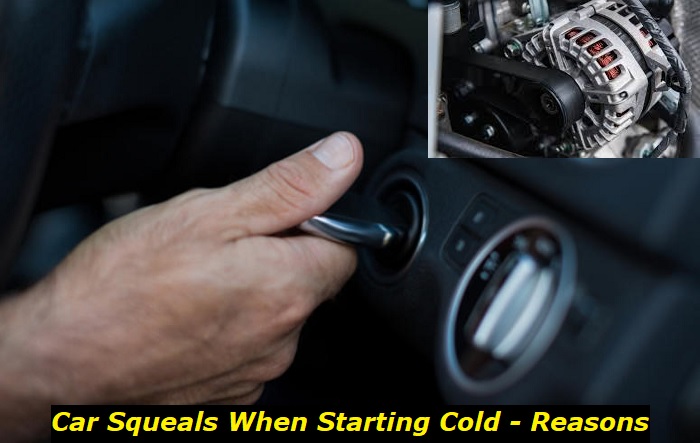Unusual sounds coming from your engine bay are usual indications of the moving parts of your vehicle that are misbehaving. These are typically due to the improper installation of parts, loose components, calibration issues, or their failure due to damage. No matter what the reason is, this warrants a systematic investigation to mitigate the risk of damage to your vehicle or prevent it altogether.
Starting engine noises highlights
- Level of urgency:High
- Can you drive?Mostly, yes
- DIY inspection:Almost impossible
- DIY repair:Impossible
- Price for repair:$250 - $900
- Common Reasons:Starter, flywheel, engine problems, belts, pulleys
- Ways to fix:Inspect everything that rotates when starting the car, replace the broken units

Most Common Causes of Squealing Sound in Your Car When Starting Cold
While the problem can stem from a lot of things, the most common places where the squealing noises could occur after a cold start are the following:
1. Slipping Belt
This kind of problem normally occurs due to temperature often affecting the shape and hold of the belt. Usually, it's a slipping serpentine belt causing this, but others such as the drive, timing, and accessory belts should also be evaluated for a good measure.
A squealing sound from the belt particularly when the car starts from cold will indicate that it's slipping and not spinning as it should. More symptoms indicating a potential slippage in the belt are an increase in engine temperature, an intermittent squeaking noise, and weak performance of accessories such as the air conditioning system and other electrical components.
A manual inspection should be done to further assess the problem, which involves checking for any broken parts or looseness in the belt. For example, if there is too much play in its movement, then this suggests that it has stretched over time and needs to be replaced with a new one. Also, you can use special tools to measure how tight the belt is with tensioners to make sure that it is within the acceptable range based on the manufacturer's requirements.
To solve the problem, any worn parts need to be replaced with new ones. Depending on the severity of the issue, you may want to consider replacing all related belts and tensioners as a precautionary measure. The serpentine belt should then be securely tightened until it reaches the manufacturer's specifications to guarantee proper performance.
Finally, always remember to check if the belt is properly aligned and free from any obstructions or damage before starting your engine again. Meanwhile, if the belt in question is still relatively new and is still deemed to be in good condition, a simple calibration may do the trick.
It's important to note that this kind of problem can also arise due to other issues such as worn-out pulleys or damaged bearings in which case more specific diagnosis and repair must be done accordingly. In addition, many manufacturers recommend inspecting and/or replacing your car's belts every 60,000 to 100,000 miles as a preventive maintenance measure. Doing so will help you avoid unnecessary repairs in the future.
2. Tensioner Wear
As its name says, the tensioner maintains the required grip and tension for the belt. When the tensioner wears out, as discussed earlier, it will cause the belt to slip and screech when starting cold. This is especially common in cars that have been on the road for many years and haven't had routine maintenance.
The other symptoms of a worn tensioner may include difficulty when shifting gears. While the belts are not directly related to the transmission, the ensuing cooling, as well as engine performance issues due to tensioner failure, can somehow trickle down to the way your transmission works. Likewise, some more consequences may include failed emissions tests due to increased oil consumption and decreased fuel economy due to timing problems. If visual evidence suggests wear and tear are present, those are cues that something is wrong with them.
The replacement of the tensioner is necessary to remedy the problem. Depending on the make and model of the car, one should refer to their service manual for instructions on how to replace the tensioner. Once more, it will be important to also replace any worn belts or pulleys if needed. After replacement, start the engine cold a few times and listen for any signs of squealing or slipping from the belt as it warms up.
3. Pulley Failure
The pulley works by aiding to generate tension in the engine belt, which allows the smooth operation of various parts as it rotates. As mentioned earlier, if a pulley fails, it can cause the belt to squeal when starting cold. Other symptoms connected to this problem are strange noises from the hood, difficulty turning the motor over, and stalling out.
For confirmatory tests, you will need to visually inspect all components related to the pulley system and observe them with an automotive stethoscope. It's also important that you check for any blockage in the crankcase ventilation system and make sure it is functioning properly. You may have to replace some worn-out parts such as the alternator drive belt or its tensioner if necessary.
In order to fix this problem, it is important to replace the pulley system with a new one. This may include the alternator drive belt and its tensioner, which should be checked for any signs of wear before installation. Be sure to lubricate all parts after installation in order to reduce friction and extend the life of your components.
4. Damaged Bearings
Damaged bearings in a car engine commonly cause squealing noises, especially when starting cold. This is because the bearing surface becomes worn, resulting in incomplete or uneven contact between the shaft and bearing. Other symptoms that could indicate damaged bearings include vibration coming from the engine while running, difficulty starting the engine even when warm, increased oil consumption, and grinding or clunking noises when shifting gears.
To aid trace the real cause of the problem, it is recommended to visually inspect the area around the bearings for any signs of wear and tear. Testing can be done using specialized tools to measure friction inside the motor. If it is determined that there are indeed damaged bearings, they should be replaced with new ones as soon as possible to avoid further damage to other parts of the engine.
The replacement parts should be of the same size and type as the original bearings to ensure proper fitment and function. If any other issues are found, it is advised to have those addressed as well in order to prevent further damage.
It is also essential to use quality lubricants when assembling new bearings, as this will help keep them running properly for longer periods of time. Proper maintenance and care can go a long way in prolonging the life and performance of car engines, so regular checks and inspections should always be done to prevent unexpected issues down the line.
5. Loose Fan Blades
When a car squeals, especially when starting cold, it can be due to loose fan blades. These fan blades aid the radiator's cooling system and are responsible for keeping the engine running smoothly and efficiently. When these fan blades become dirty, loose, or unbalanced, they can cause excessive vibration which will result in a loud squealing noise. In addition to this noise, other symptoms that may accompany this problem include poor temperature and performance management in the vehicle.
To ascertain if this is indeed the issue with your vehicle, start by visually inspecting signs of dirt accumulation or wear on the fan blades and rotor. Check its mounting and installation for possible problems, too. Similarly, you can use a multimeter to check whether or not it is getting enough power to enable it to spin within the required speeds.
Once confirmed that the problem is due to wear on this component, it is important to replace the fan assembly with new parts that are properly balanced and securely tightened. If dirt accumulation or misalignment is only the reason for your trouble, a simple cleaning or adjustment of its components may fix it. On the other hand, if issues persist even after replacement, then further investigation may be required to determine what else may be causing this problem.
Conclusion
No matter what the cause of your squealing problem is during cold starts, it may be helpful to seek aid from a mechanic experienced in auto repairs and parts replacement. Certified mechanics can help ensure that the job is done correctly. They can also help reduce the sum of repair costs in the long run because they are more properly equipped with tools and knowledge in this kind of job. Taking these steps can save time, money, and hassle in the future.
Furthermore, it is important to note that while the problems enumerated here are among the most common causes of car squealing noises during cold starts, other factors could be at play. Again, for that reason, it is best to consult a qualified professional for a more thorough evaluation of the trouble you are encountering.
About the authors
The CarAraC research team is composed of seasoned auto mechanics and automotive industry professionals, including individuals with advanced degrees and certifications in their field. Our team members boast prestigious credentials, reflecting their extensive knowledge and skills. These qualifications include: IMI: Institute of the Motor Industry, ASE-Certified Master Automobile Technicians; Coventry University, Graduate of MA in Automotive Journalism; Politecnico di Torino, Italy, MS Automotive Engineering; Ss. Cyril and Methodius University in Skopje, Mechanical University in Skopje; TOC Automotive College; DHA Suffa University, Department of Mechanical Engineering






Add comment